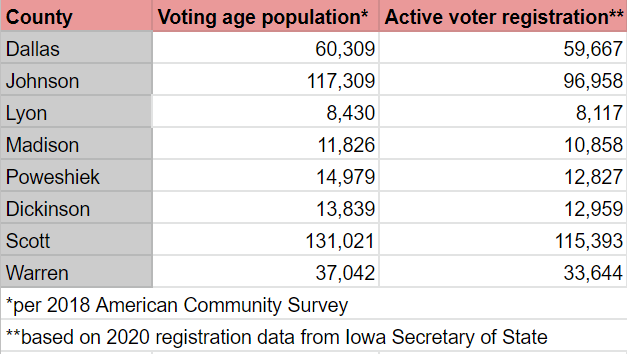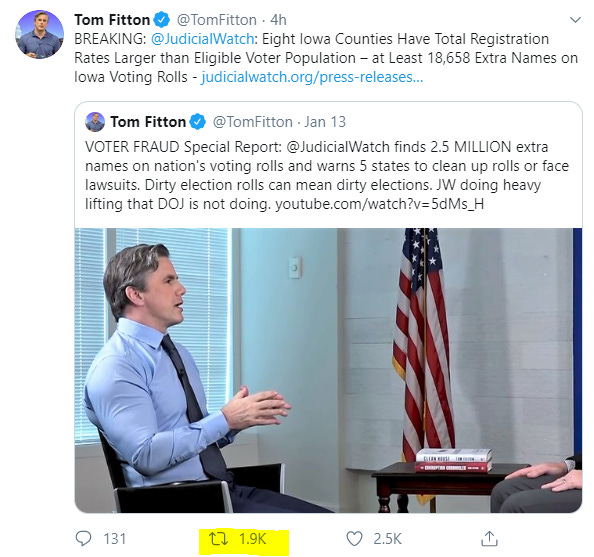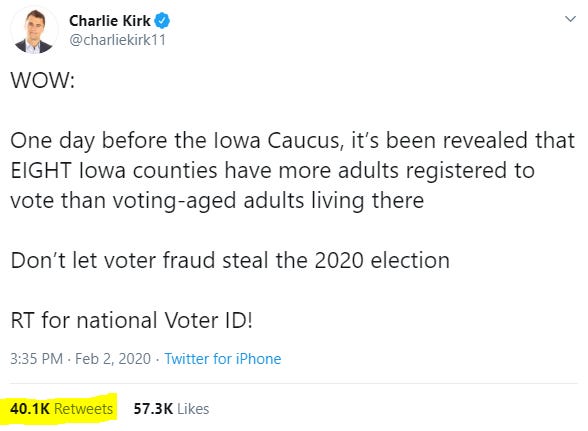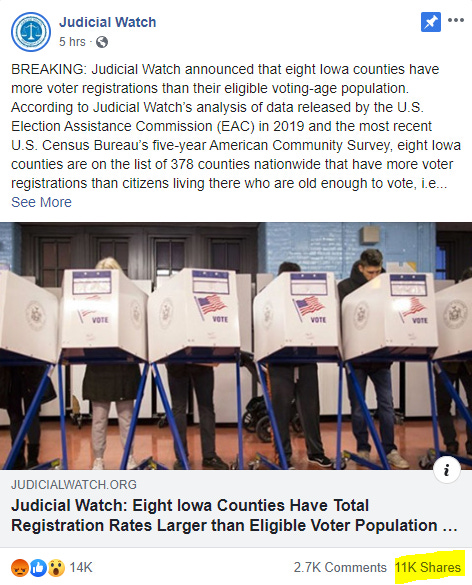Lying with numbers
While Democratic candidates were seeking to turn out voters in Iowa, Trump's allies were pushing false narratives to lay the groundwork for voter suppression.
Making it more difficult to vote is a key Republican strategy. It involves creating rules that prevent people who show up to polls from voting. A central aspect of the strategy is establishing that in-person voter fraud is rampant. But in-person voter fraud is practically non-existent. So Trump supporters have gotten creative.
Judicial Watch, a right-wing organization, issued a press release on Monday morning that falsely claimed, "eight Iowa counties have more voter registrations than their eligible voting-age population." The purpose of this kind of claim is to justify voter purges to kick people off the voter rolls.

Judicial Watch's chart includes outdated data of the total population of each county, rather than the voting-age population. For example, Judicial Watch claims that the total population of Johnson County is 144,425. But, according to the latest Census data from 2018, the voting-age population is 117,309.
More importantly, Judicial Watch also misstates the registration rate of every county. Judicial Watch claims there is a 107.9% voter registration rate in Johnson County. But, according to the latest data from the Iowa Secretary of State, released Monday at 8AM, there are only 96,958 active registered voters in Johnson County. So the actual registration rate is not 107.9%; it's 82.7%.
There are similar issues in all the country data released by Judicial Watch. Here is the accurate data for each county:

While Judicial Watch claims the registered population exceeds 100% of the voting population in these eight counties, active registered voters do not exceed 100% of the voting-age population in any of the counties.
The counties also maintain a list of inactive voters that the state believes have moved. These voters would be unlikely to be included in population surveys because most have moved. If they don't vote, they are removed from the rolls. If inactive voters do show up, they can vote with an ID. This essentially treats inactive voters like unregistered voters. Iowa allows same-day registration if Iowans show an ID or other proof of residence.
In two counties, Dallas and Lyon, the number of 2020 active and inactive voters slightly exceed the voting-age population in 2018. This is not an indicia of fraud. It's an indication that, in any county, some people move in, and other people leave.
Judicial Watch also inverts the measure of a well-functioning democracy. A healthy democracy should strive to have as close to 100% of the eligible population registered as possible. That might mean, in some cases, that total registration temporarily exceeds the population as measured by the Census. The latest estimate from the Census is from 2018, and many counties are growing.
But Judicial Watch wants to take 100% registration and turn it into a prima facia case for fraud.
The velocity of misinformation
Judicial Watch's data is wrong. Don't take it from me. Take it from Iowa's Republican Secretary of State, Paul Pate:
It’s unfortunate this organization continues to put out inaccurate data regarding voter registration, and it’s especially disconcerting they chose the day of the Iowa Caucus to do this. My office has told this organization, and others who have made similar claims, that their data regarding Iowa is deeply flawed and their false claims erode voter confidence in elections. They should stop this misinformation campaign immediately and quit trying to disenfranchise Iowa voters.
Pate tweeted his rebuttal to Judicial Watch's release. As of Monday afternoon, Paul's tweet had accumulated ten retweets. By that point, a tweet by Judicial Watch President Tom Fitton already had over 1,900 retweets.

A follow-up tweet by Fitton, defending his data as accurate, gained another 900 retweets. And a Twitter thread by the Judicial Watch account had over 1,000 total retweets.
That's just the tip of the iceberg. A tweet promoting the false Judicial Watch report by Charlie Kirk, the president of Turning Point USA, has over 40,000 retweets.

Twitter just made a splashy announcement that it was going to fight misinformation about voting. "As caucuses and primaries for the presidential election get underway, we’re building on our efforts to protect the public conversation," a Twitter spokesperson said. But Twitter told the Washington Post that tweets about the Judicial Watch report did not violate its policy.
Things are not much better on Facebook. As of Monday afternoon, Judicial Watch's post about its false report was shared 11,000 times.

The Iowa Secretary of State posted his rebuttal on Facebook and received 24 shares.

Facebook relies on a small number of fact-checkers to police all of the content published on its site. This means, in most cases, false political information is not even noticed, much less checked. But late Monday, one of Facebook's independent fact-checking partners, Lead Stories, flagged the Judicial Watch report as false, prompting users who attempted to share the Judicial Watch report to get a warning.
Although Facebook allows politicians and parties to lie in ads, it prohibits advertisements from other sources from including information debunked by one of its fact-checkers. But despite the ruling by Lead Stories, Facebook did not immediately remove an ad by Judicial Watch promoting its report.

In response to a question about why the ad was still up despite being ruled false, a Facebook spokesperson responded that it would be removed shortly. At about 9:45PM Eastern on Monday night, approximately three hours after Popular Information's initial inquiry, the ad was finally removed.
Thanks for reading!



This needs to be a public post, Judd. It’s too important not to be
I don't know that it can be seriously disputed any longer that the social media giants are in the pocket of the Republicans. It's sad, and equally disheartening to know that so many people fall for their disingenuous protestations that they are "just trying to be fair".